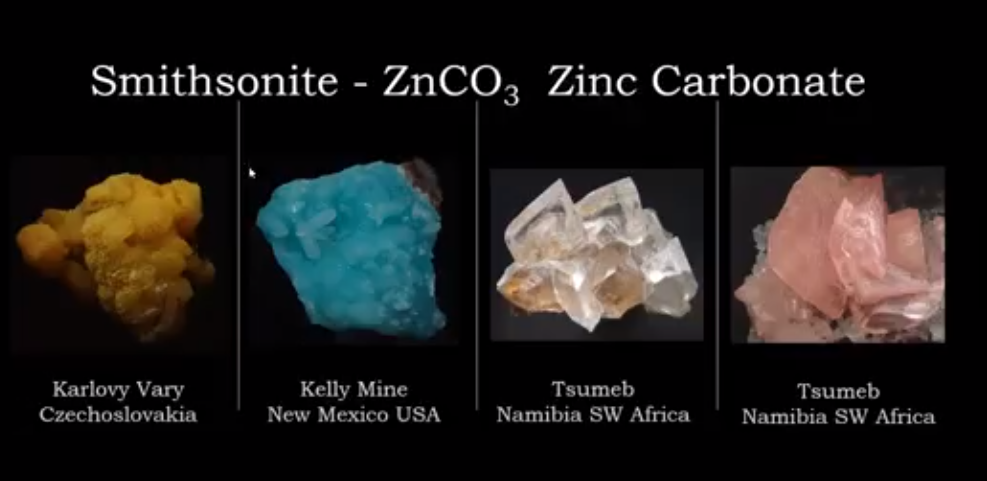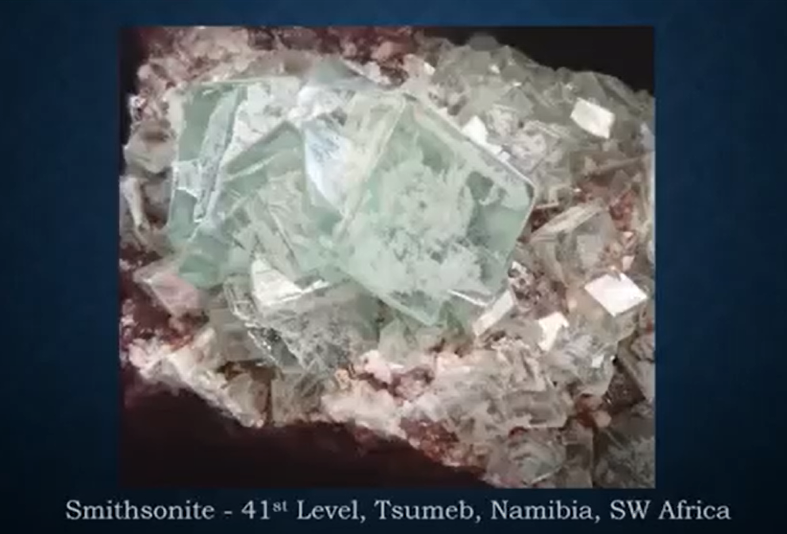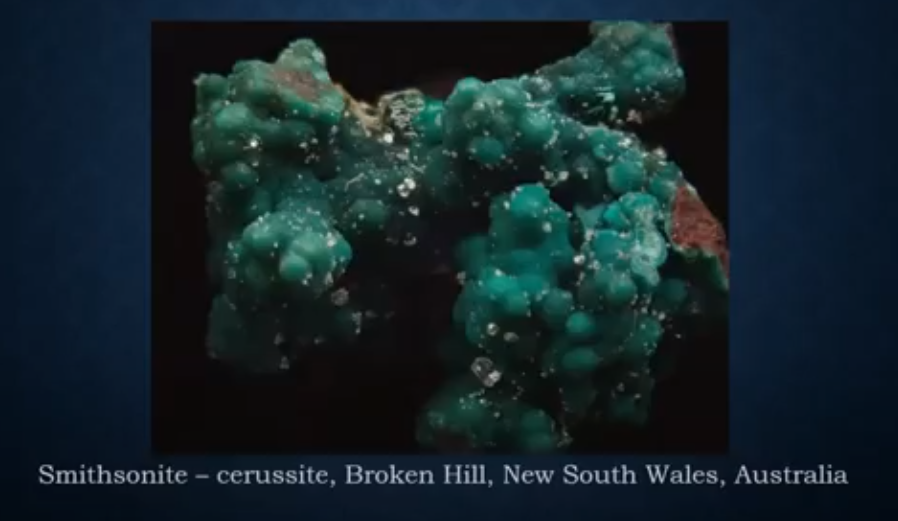My Smithsonite Micromineral Collection & The Legacy of James Smithson
Summary of December 1st Program, presented by Kathy Hrechka
Synopsis by Andy Thompson, MSDC Secretary
Kathy's December presentation consisted of two parts. The first focused on smithsonite and sharing images from her collection, as well as some of the Smithsonian’s specimens from around the world. The second part connected this mineral to the legacy of the British chemist James Smithson.
The Many Forms of Smithsonite
Kathy introduced the first half of her presentation with four pictures of her micromineral specimens and a question: which one is smithsonite?

Although all appeared to have different crystal shapes and colors, all, she said, were smithsonite.
Kathy shared her method when she finds herself having questions about a mineral. She said she begins by turning to Mindat which has abundant information on all things mineralogical. There (mindat.org) she found smithsonite described as:
· relatively soft (Mohs scale 4 to 4.5)
· composed of zinc carbonate (ZnCo3)
· having practically every color in the rainbow
· with a trigonal crystal structure, and
· a member of the calcite group.
Mindat also provided a brief introduction to the second half of Kathy’s presentation. It noted that James Smithson in 1803 presented his research findings on the mineral calamine and his discovery that it had two forms, a carbonate and silicate. He died in 1829 and just three years later, in 1832, in his honor, the carbonate variety of calamine he was studying was officially named “smithsonite.” Further, according to the terms of his will which he drafted in 1826, he donated essentially all of his worldly possessions to the United States and thereby became the founding benefactor of the Smithsonian Institution.
Kathy then transitioned to today’s Smithsonian National Museum of Natural History (NMNH) and to the calcite display case shown below. She noted the similarities between calcite, CaCO3, and smithsonite, ZnCO3. The exhibit shows calcites in three crystal forms: trigonal prisms, scalenohedron, and rhombohedron.


Smithsonite has the same trigonal crystal structure as do many calcite minerals. Visitors to the NMNH will find smithsonite exhibited in the above case and elsewhere in the exhibit. Note that “GGM” on the slide above, refers to Janet Annenberg Hooker Hall of Geology, Gems, and Minerals on the second floor of the museum.
Kathy gave an explanation of which impurities in smithsonite may contribute to the eight colors that the mineral typically displays. She took the vast majority of the excellent photos she shared with MSDC members.

The photo below contrasts the large volleyball-sized botryoidal specimen from the Kelly mine, Socorro County, New Mexico, located in the GGM display, with Kathy’s tiny micromineral specimen on the left (FOV refers to the field of view, in this case 8mm, about the width of the eraser on a standard pencil).

She noted that in 2012, she was intrigued by the NMNH display of smithsonite minerals from Tsumeb, Namibia in southwestern part of Africa. That inspired her to begin collecting smithsonite from around the world. Kathy transitioned from describing the Smithsonian collection’s display to showing and describing the photos of her own micromineral collection of smithsonite microminerals.

Smithsonite Microminerals
Kathy then displayed, in rapid succession, about a dozen diverse Tsumeb specimens she has collected and photographed. The second light-green specimen, below, is one of her favorites.


Kathy attended the Socorro, NM Symposium in mid-November 2021 where her friend, Pat Haynes, provided her with an assortment of 50 smithsonite micros from Socorro, NM.

Kathy showed two of her favorites from the Kelly Mine, which exhibited particularly beautiful blue and green colors due to their trace elements of copper.

Kathy also displayed dozens of microminerals from diverse locations throughout the U.S. with many having interesting aspects. One example is the smithsonite from Gila County, Arizona, shown below. Dr. Virgil Lueth from NM provided an abstract on colors of smithsonite. His research on the 79 Mine from Gila, County, AZ associates its green color with a combination of reduced trace amounts of copper and the presence of manganese.

Another of her favorites, pictured below, she said, is from Utah. The yellow crystals are smithsonite while the blue-green are the azurite and malachite.

The “global” aspect of Kathy’s collection was also very well represented by dozens of interesting specimens from beyond the U.S. Below is a smithsonite identified as from Czechoslovakia. Its beautiful yellow color is due to trace amounts of cadmium.

Pictured below, from down under in New South Wales, Australia, is a beautiful green botryoidal smithsonite specimen topped with tiny white cerussite minerals.

James Smithson’s Legacy
The second half of Kathy’s presentation focused on the legacy of James Smithson. One aspect of that legacy is Smithson’s financial contribution which enabled the establishment of the Smithsonian Institution. It included 104,960 British pounds, all in gold sovereigns, as noted in the following slide, in which the coinage is a story by itself.

That financial inheritance supported the establishment of the Smithsonian Institution. The first S.I. building, the Castle, below, originally housed his donation of minerals, books and, much later (1904), his personal remains.

Kathy next commented further about the little-known origins of the British chemist who first envisioned and enabled the creation of the Smithsonian Institution. She explained that upon his graduation from Oxford, when he was known as James Lewis Macie, he became a member of the Royal Society at the age of 21. When his biological mother, Elizabeth Hungerford Macie, died in 1801, James changed his last name from Macie and took his biological father’s original name, Smithson.

She drew on and recommended a recent biography of Smithson written by Steven Turner.

Kathy noted that Turner recreated a number of Smithson’s chemical experiments using the same type of equipment as Smithson used. As a result, Turner concluded that Smithson had been at the forefront of chemical experimentation, including, for example, his dexterous use of a blow pipe. Such ingenuity enabled Smithson to generate and work with higher temperatures and make experimental breakthroughs including distinguishing between the two types of calamines, carbonite of zinc and silicate of zinc. Kathy noted that in 1802, Smithson delivered his paper, “A Chemical Analysis of Some Calamines,” and it became an important part of his legacy.
Kathy shared that, based on Smithson’s extensive collection of tiny specimens, she believed he was indeed a micromounter. As evidence, she cited page 137 of Heather Ewing’s book, The Lost World of James Smithson, which describes his extensive collection of perfect tiny specimens.

Kathy also explained the complexities of Smithson’s family connections, his will, and the U.S. government’s eventual decision to build the “Smithsonian Institution” on the Washington, DC mall.

Kathy then shared some slides and stories of her travels, especially to England, to pursue knowledge about smithsonite. She also strongly recommended, based on her own experience, the benefits of serving as a volunteer within the Smithsonian's NMNH. She highlighted her pleasure in helping to educate visitors to the Geology, Gems, and Mineral Hall by presenting the “Periodic Table of a Smartphone” which describes the 35 native elements used in making Smartphones.

She concluded by sharing photos of her home office and lab, above, as well as of her coworkers at the NMNH and its director, Dr. Kirk Johnson. Lastly, she described her affiliation with the DC Micromineralogists club, and a photo, generated by an app, which features her “wearing” the Hope diamond. She used the same app to take similar photos of NMNH visitors. She expressed her gratitude for the staff of the NMNH Mineral Department, her colleagues and family. Kathy concluded with photos describing the pleasure of her career choice as a flight attendant.

Question and Answer Session
MSDC President Dave Hennessey thanked Kathy for her interesting presentation and the Zoom attendees joined in with their applause. Dave noted Kathy had referred to a club, the Micromineralogists of the National Capital Area, which spun off from the Mineralogical Society of the District of Columbia half a century ago. In 2017, members of the two sister clubs joined together to celebrate their respective anniversaries, the 75th for MSDC and 50th for MNCA.
Dave then asked if there were any questions for Kathy. Queries included how to tell the difference between the two types of calamine minerals, why no smithsonite has been found in the Franklin, NJ area, and Peter Chin’s discussion of the forthcoming 3 volume work, The Mineralogy of the Franklin and Ogdensburg New Jersey.
With the conclusion of the sharing and discussion of minerals, President Dave Hennessey again thanked Kathy for her wonderful presentation and his appreciation for all who shared in the evening’s discussions. He closed out the meeting wishing everyone a happy and safe holiday.
